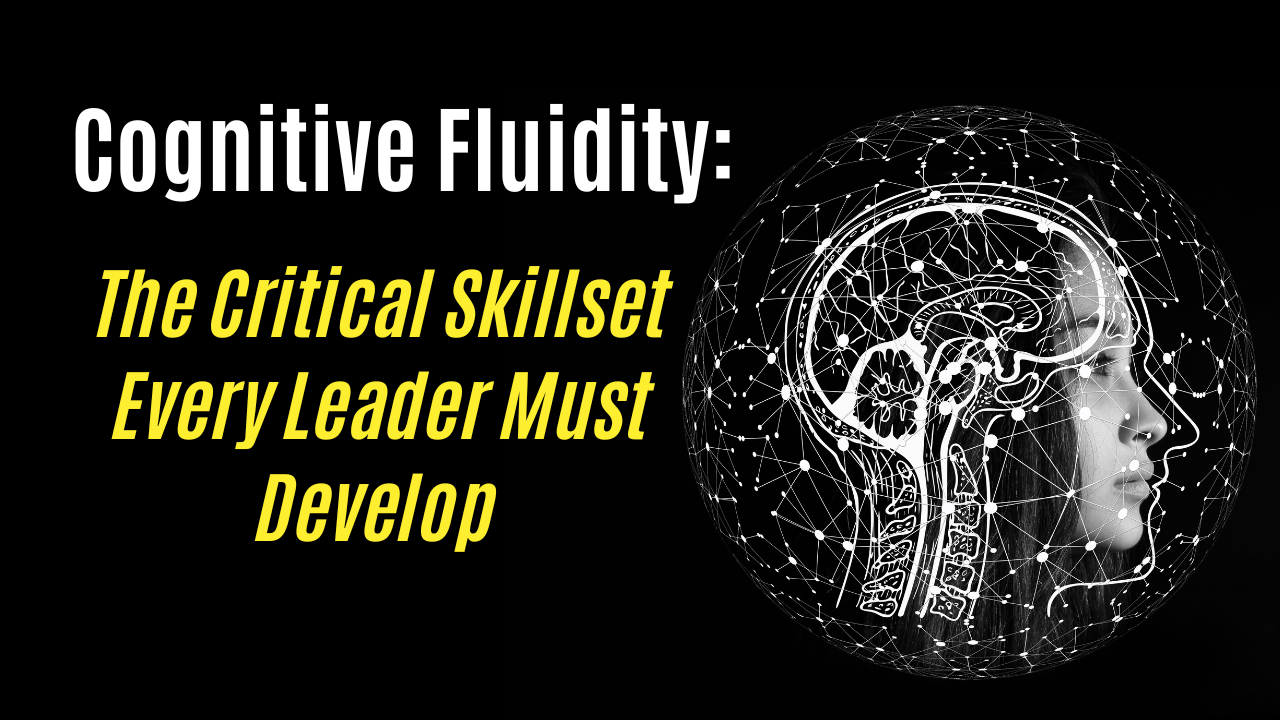Leadership Isn’t About Being Smart—It’s About How You Use Your Brain
When we think of great leaders, intelligence often comes to mind. But leadership isn’t just about being smart—it’s about how effectively you use your brain. The most successful leaders don’t just accumulate knowledge; they navigate complexity, adapt quickly, and think creatively.
This ability to shift between different modes of thinking, problem-solving, and decision-making is known as cognitive fluidity—and it might be the most important skill you’re not developing.
What Is Cognitive Fluidity?
Cognitive fluidity refers to the brain’s ability to transition seamlessly between different types of thinking, such as analytical, creative, and strategic reasoning. It allows leaders to process new information, make connections between seemingly unrelated ideas, and pivot when circumstances change.
Cognitive fluidity isn’t just a theoretical concept; it’s rooted in neuroscience. Research shows that the ability to shift between different cognitive modes is linked to increased problem-solving skills and better decision-making (Diamond, 2013).
Leaders who exhibit high cognitive fluidity are more resilient, innovative, and adaptable—key traits for navigating today’s rapidly changing business landscape.
The Six Components of Cognitive Fluidity in Leadership
There are six components of Cognitive Fluidity that I assess and build when working with leaders.
- Cognitive Flexibility – The ability to shift thinking and adapt to new information, perspectives, or challenges without getting stuck in rigid thought patterns.
- Associative Thinking – The capacity to connect seemingly unrelated ideas, which fosters innovation and problem-solving.
- Mental Adaptability – The resilience to adjust and rethink strategies in the face of uncertainty or failure.
- Divergent Thinking – The ability to generate multiple solutions to a problem rather than getting locked into a single approach.
- Cognitive Load Management – The skill of efficiently processing and prioritizing information without becoming overwhelmed.
- Working Memory – The ability to hold and manipulate information in real-time, enabling better decision-making under pressure.
When these six components are developed and strengthened, leaders become more agile, creative, and effective in solving problems and driving success.
The Impact of Cognitive Fluidity on Leadership Effectiveness
Cognitive fluidity affects leadership in profound ways:
- Better Decision-Making: Leaders who can shift perspectives and see multiple solutions make more well-rounded, strategic decisions (Scott et al., 2018).
- Improved Problem-Solving: Associative thinking allows leaders to draw from diverse experiences and knowledge bases, leading to creative and effective solutions.
- Greater Adaptability: In a world of constant change, leaders who exhibit mental adaptability thrive while those stuck in rigid thinking falter.
- Stronger Team Leadership: Leaders with high cognitive fluidity are better at managing diverse teams, as they can adjust their approach based on team dynamics and challenges.
- Increased Innovation: Cognitive flexibility and divergent thinking drive innovation by enabling leaders to see new opportunities where others see roadblocks.
Five Science-Backed Ways to Build Cognitive Fluidity
Here’s the good news. Cognitive fluidity isn’t fixed—it can be trained and strengthened. Here are five evidence-based ways to develop this critical leadership skill:
- Engage in Cross-Disciplinary Learning
Exposing yourself to different fields and industries enhances associative thinking. Research shows that learning across domains strengthens neural connections and improves problem-solving (Simonton, 2004). Read books outside your expertise, attend diverse conferences, and engage in conversations with people from different industries. - Practice Mental Shifting Exercises
Training your brain to switch between tasks and viewpoints can increase cognitive flexibility. One effective method is the Stroop Task, where individuals identify colors of words that spell out different colors (e.g., the word “blue” written in red ink). Studies suggest such exercises enhance mental adaptability and working memory (Diamond, 2013). - Embrace Uncertainty and Experimentation
Leaders who challenge themselves with new experiences build mental adaptability. One way to do this is by intentionally putting yourself in unfamiliar situations—whether that’s taking on a project outside your expertise or traveling to a new country. This discomfort forces the brain to adapt and form new cognitive patterns (Heersmink, 2017). - Use Mind Mapping for Divergent Thinking
Mind mapping, where you visually connect ideas in a nonlinear way, helps unlock creativity and divergent thinking. A study by Eppler (2006) found that mind mapping enhances idea generation and problem-solving by fostering nontraditional connections between concepts. Break out the sheet of paper and pen or that dry-erase board and makers. Then start depicting, drawing, and connecting. - Manage Cognitive Load Through Strategic Prioritization
Information overload can hinder cognitive fluidity. Leaders can improve cognitive load management by using techniques like the Eisenhower Matrix to categorize tasks by importance and urgency. Research suggests that prioritization strategies enhance working memory and executive functioning (Miyake & Friedman, 2012).
Leadership in today’s fast-changing world isn’t about knowing all the answers—it’s about thinking in ways that allow you to find the best answers. Cognitive fluidity is the key to making better decisions, leading teams effectively, and driving innovation. By developing cognitive flexibility, adaptability, and thinking skills, you can transform your leadership effectiveness and thrive in any environment.
Smart leaders don’t just accumulate knowledge—they master how to think. The more fluid your cognition, the more powerful your leadership becomes.
References:
- Diamond, A. (2013). Executive functions. Annual Review of Psychology, 64, 135-168.
- Eppler, M. J. (2006). A comparison between concept maps, mind maps, conceptual diagrams, and visual metaphors as complementary tools for knowledge construction and sharing. Information Visualization, 5(3), 202-210.
- Heersmink, R. (2017). Distributed cognition and the cognitive artifacts of human-computer interaction. Mind & Language, 32(1), 3-24.
- Miyake, A., & Friedman, N. P. (2012). The nature and organization of individual differences in executive functions: Four general conclusions. Current Directions in Psychological Science, 21(1), 8-14.
- Scott, G., Leritz, L. E., & Mumford, M. D. (2018). The effectiveness of creativity training: A quantitative review. Creativity Research Journal, 16(4), 361-388.
- Simonton, D. K. (2004). Creativity in science: Chance, logic, genius, and zeitgeist. Cambridge University Press.

